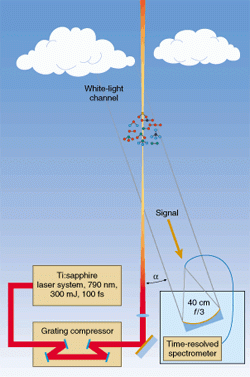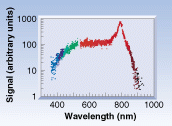
Uwe Brinkmann
France's Centre National de la Recherche Scientifique and the Deutsche
Forschungsgemeinschaft are providing DM 2.5 million ($1.35 million) over
the next two years to support a research project to develop a mobile terawatt
white-light lidar system (see figure). The device will combine the height-resolution
advantage of differential-absorption lidar and the multicomponent-analysis
capability of differential optical absorption spectroscopy.
Project participants include Roland Sauerbrey and his research team
at the Friedrich-Schiller-Universität Jena (Jena, Germany), Ludger Wöste
and colleagues at the Freie Universität Berlin (Berlin, Germany), André
Mysyrowicz and his research team at the Ecole National Supérieure
de Techniques Avancées (Paris, France), and Jean-Pierre Wolff and
associates at the Université Claude Bernard de Lyon (Lyon, France).
Universität Jena (Jena, Germany), Ludger Wöste and colleagues
at the Freie Universität Berlin (Berlin, Germany), André Mysyrowicz
and his research team at the Ecole National Supérieure de Techniques
Avancées (Paris, France), and Jean-Pierre Wolff and associates at
the Université Claude Bernard de Lyon (Lyon, France).


PHOTO. Using peak powers up to 2.5 TW, lidar system will form a plasma
channel in the atmosphere when a laser beam is focused or self-focuses. The
backscattered white light emitted from that region will then be spectrally
analyzed (see inset, colorized for visualization).
The femtosecond-pulse technique will generate white-light pulses
with a chirped-pulse-amplification Ti:sapphire laser (790 nm) having pulse
energy up to 250 mJ, 100-fs pulse duration, and a 10-Hz repetition rate.
This light will be directed into the sky through a plasma channel developed
by the system. The light backscattered from the channel will then be analyzed
spectrally to simultaneously trace the water-vapor distribution, ozone, and
other trace gases such as methane (CH4), sulphur dioxide (SO2),
or nitrous oxide (NOx) in the atmosphere.
In preliminary laboratory experiments at the Universität Jena,
in collaboration with the Berlin project group, researchers investigated
the electrical properties of the plasma channels. They reported the detection
of free laser-induced charges along the light filament produced by the laser
beam.1 During tests of the system, the scientists positioned a
channel-like source of white light in the atmosphere by adjusting the arrival
time of the spectrally dispersed laser pulse in the focus. The system detected
backscatter signals from as high as 13 km; recorded spectra indicated that
the white-light source can be favorably used for absorption measurements.
The channel produced extended along the laser beam across a considerably
longer distance than the short geometrical focal region. Even the free-propagating
beam contracted and finally self-focused—a fact explained by the interplay
of refractive-index modulation due to the intensity-dependent optical Kerr
effect and diffraction.
For lidar applications, the white-light source can be shifted along
the optical axis of the laser beam by changing both the focal length and
the overlap of the spectral components of the laser pulse (control of group-velocity
dispersion). This shifting opens the possibility of performing absorption
measurements of different optical lengths and positioning the white-light
source behind an atmospheric layer of interest.
The researchers plan to investigate the principal propagation properties
of intense laser pulses in air, the plasma channeling process, and the application
of multicomponent white-light lidar at large facilities where no high-power
laser is available but is needed. The system may also be combined with larger
astronomical telescopes to enhance the detection sensitivity of the system
or act as guide star for the astronomers. Other possible uses include atmospheric
research and pollution detection. In addition, the researchers believe the
conductive properties of the laser-induced channel could be used for lightning
control near airports, power plants, or other sites.
Uwe Brinkmann
- Appl. Phys. B 68, 753 (1999).
Laser Focus World November, 1999

Copyright © 2003 - PennWell Corporation. All rights
reserved.


